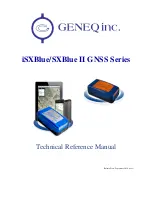
X
X
L
L
D
D
C
C
M
M
A
A
N
N
.
.
d
d
o
o
c
c
3
3
-
-
5
5
R
R
E
E
V
V
E
E
There are two choices for SURVEY operation: STATIC and DYNAMIC. STATIC should be used when
the mode of operation is pseudo-static, i.e. the unit is periodically transported to a new location and
then stationary operation is performed at the new location. In this mode, the GPS core receiver will
easily maintain lock under the dynamics experienced during ground transport and will quickly provide
accurate time and frequency once at the new site. This mode also supports operation with a single
satellite once the position at the new site has been determined. However, if operation while moving is
important and the possibility of satellite obstruction exists, STATIC should not be selected as erroneous
time and frequency steering data could be used while only a single satellite is visible.
DYNAMIC should be selected when operation is truly dynamic and might possibly include high
acceleration or velocity such as might be experienced on-board tactical aircraft. In this mode, satellite
visibility must be complete and fall-back to single satellite operation is not supported.
3-13 TIME MODE
When in the TIME operational mode, the XL-DC disables updating of the reference position average
and computes timing solutions based on either the previously averaged position or a reference position
which has been input via either Keypad or Serial Function 56. However, each position fix update is
tested against the reference position to detect possible relocation of the receiver and antenna during
the last power off period. If the XL-DC determines that it has been moved by more than 1 km, it will
automatically set itself into the AUTO mode of operation.
Up to six satellites are used for timing solutions, enabling significant reduction of the effects of Selective
Availability on the stability and accuracy of the timing and frequency outputs and measurement data.
These satellites are chosen to be the highest ones currently available.
3-14 through 3-19 reserved
3-20 TIME QUALITY INDICATION
Whenever the XL-DC is not tracking satellites, the timing accuracy will be dependent upon the accuracy
and stability of the currently selected oscillator (internal or external). Time error accumulates
depending upon the stability of the oscillator used and the accuracy to which it was set prior to loss of
GPS steering information. The XL-DC continually calculates an estimate of the "worst-case time error".
When the receiver is tracking satellite signals and is operating from a known position, the worst-case
error is 200 ns. If lock with all satellite signals is lost, the Serial Function F53 command returns "F53
MODE: 0 SATS", where "MODE" is the current operating mode, i.e. AUTO, SURVEY, TIME. If the time
quality indicator character is enabled (see SERIAL FUNCTION 11 - OUTPUT FORMAT
ENTRY/REQUEST) then the time string returned by either Serial Function F08 or F09 will indicate the
worst-case time error with a different character for each of four thresholds. The user may enable,
disable and set these thresholds using Serial Function F05. As shipped, these indicators are enabled
and the default thresholds are:
First threshold
- 1
µ
s
Second threshold
- 10
µ
s
Third threshold
- 100
µ
s
Fourth threshold
- 1000
µ
s
Summary of Contents for 151-600
Page 2: ...Model XL DC Serial Number__________________ September 15 1997 Revision E...
Page 4: ......
Page 27: ...X...















































